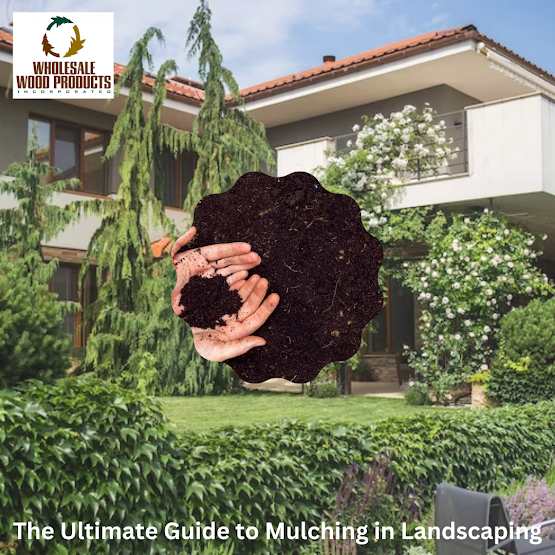The Ultimate Guide to Mulching in Landscaping
Landscaping isn't just about arranging plants and flowers—it's about creating a sustainable and visually appealing outdoor environment. One crucial element that plays a pivotal role in achieving this is mulch. Mulching is a fundamental practice in landscaping that offers numerous benefits, from enhancing aesthetics to improving plant health and soil quality. We will now enter into the world of mulching, covering everything from the types of mulch available to step-by-step installation instructions given by leading suppliers of premium quality mulch in Lilburn locality. Whether you're a seasoned gardener or a landscaping enthusiast, this ultimate guide to mulching will help you make the most of this essential landscaping technique.
Why Mulch Matters
The Ultimate Guide to Mulching in Landscaping
Before we dive into the specifics, it's essential to understand why mulch is a cornerstone of landscaping. Mulch serves multiple purposes, including:
- Weed Suppression: Mulch creates a barrier that prevents weed growth, reducing the need for labor-intensive weeding.
- Moisture Retention: Mulch helps soil retain moisture, reducing the frequency of watering and conserving water resources.
- Temperature Regulation: It acts as an insulator, protecting plant roots from extreme temperatures and temperature fluctuations.
- Soil Improvement: As mulch breaks down, it enriches the soil with organic matter, improving its structure and fertility.
- Aesthetic Enhancement: Mulch adds a polished look to gardens and landscapes, creating tidy, well-defined spaces.
Now, let's explore the different types of mulch you can use and when to use them.
Types of Mulch
Mulch comes in various materials, each with its unique characteristics and applications. Here are some common types of mulch:
1. Organic Mulch
Wood Chips or Bark: Made from shredded or chipped tree bark or wood, this mulch offers good moisture retention and a natural look.
Straw: Often used in vegetable gardens, straw mulch is excellent for moisture retention and weed suppression.
Leaves: Shredded leaves make for an eco-friendly mulch choice and provide organic matter as they decompose.
2. Inorganic Mulch
Gravel or Stones: These types of mulch don't break down but are excellent for weed control and drainage.
Rubber Mulch: Made from recycled rubber, it's long-lasting and provides good weed control.
3. Living Mulch
Ground Covers: Low-growing plants like creeping thyme or clover serve as living mulch, reducing soil erosion and weeds.
4. Plastic or Landscape Fabric
Plastic Sheeting or Landscape Fabric: These are used to smother weeds but may not be as aesthetically pleasing as organic mulches.
Each type of mulch has its advantages and disadvantages, making it important to choose the one that suits your landscaping needs and preferences.
When to Mulch
Timing is crucial when it comes to mulching. Here's when you should consider mulching:
- Spring: Apply mulch in spring to suppress early-season weeds and conserve soil moisture for the growing season.
- Summer: Replenish mulch in the summer to maintain moisture levels and regulate soil temperature during hot months.
- Fall: Fall mulching helps insulate plant roots from winter cold and prevents frost heaving.
- Winter: In regions with harsh winters, mulch can provide an extra layer of insulation and protect plants from extreme cold.
How to Mulch: Step by Step
Now that you understand the why, what, and when of mulching, let's walk through the process of mulch installation:
Step 1: Prepare the Area
Remove any weeds, debris, or old mulch from the area.
Ensure the soil is evenly graded and moist.
Step 2: Choose the Right Mulch
Select the type of mulch that suits your landscaping goals and aesthetics.
Step 3: Apply Weed Barrier
If using organic mulch, consider laying down a weed barrier fabric to suppress weed growth further.
Step 4: Apply Mulch
Spread the mulch evenly across the area, creating a layer about 2 to 4 inches deep. Avoid piling mulch against tree trunks or plant stems.
Step 5: Maintain Edges
Maintain clean edges around garden beds or tree bases for a polished look.
Step 6: Water
Water the mulched area thoroughly to settle the mulch and promote moisture retention.
Step 7: Monitor and Refresh
Regularly inspect your mulch for signs of compaction or thinning. Refresh it as needed, especially in high-traffic areas.
Common Mulching Mistakes to Avoid
While mulching is a straightforward practice, it's essential to avoid common mistakes, such as:
- Over-Mulching: Applying mulch too thickly can suffocate plants and prevent proper water infiltration.
- Volcano Mulching: Piling mulch against tree trunks can lead to rot and disease. Maintain a mulch-free zone around the base of trees.
- Neglecting Weed Barriers: If you use organic mulch, consider using a weed barrier fabric to enhance weed suppression.
- Ignoring Refreshment: Mulch breaks down over time; be sure to replenish it as needed to maintain its effectiveness.
Conclusion
In the world of landscaping, mulching is a simple yet powerful practice that can transform your outdoor spaces. By understanding the types of mulch available, the timing for mulch application, and the proper installation techniques, you can harness the full potential of mulch in your garden or landscape. Remember to choose the right type of mulch provided by your local supplier Wholesale Wood Products, apply it correctly, and avoid common mulching mistakes to enjoy the myriad benefits it offers. With this ultimate guide to mulching, you're well-equipped to embark on a landscaping journey that is both visually stunning and environmentally sustainable.



Comments
Post a Comment